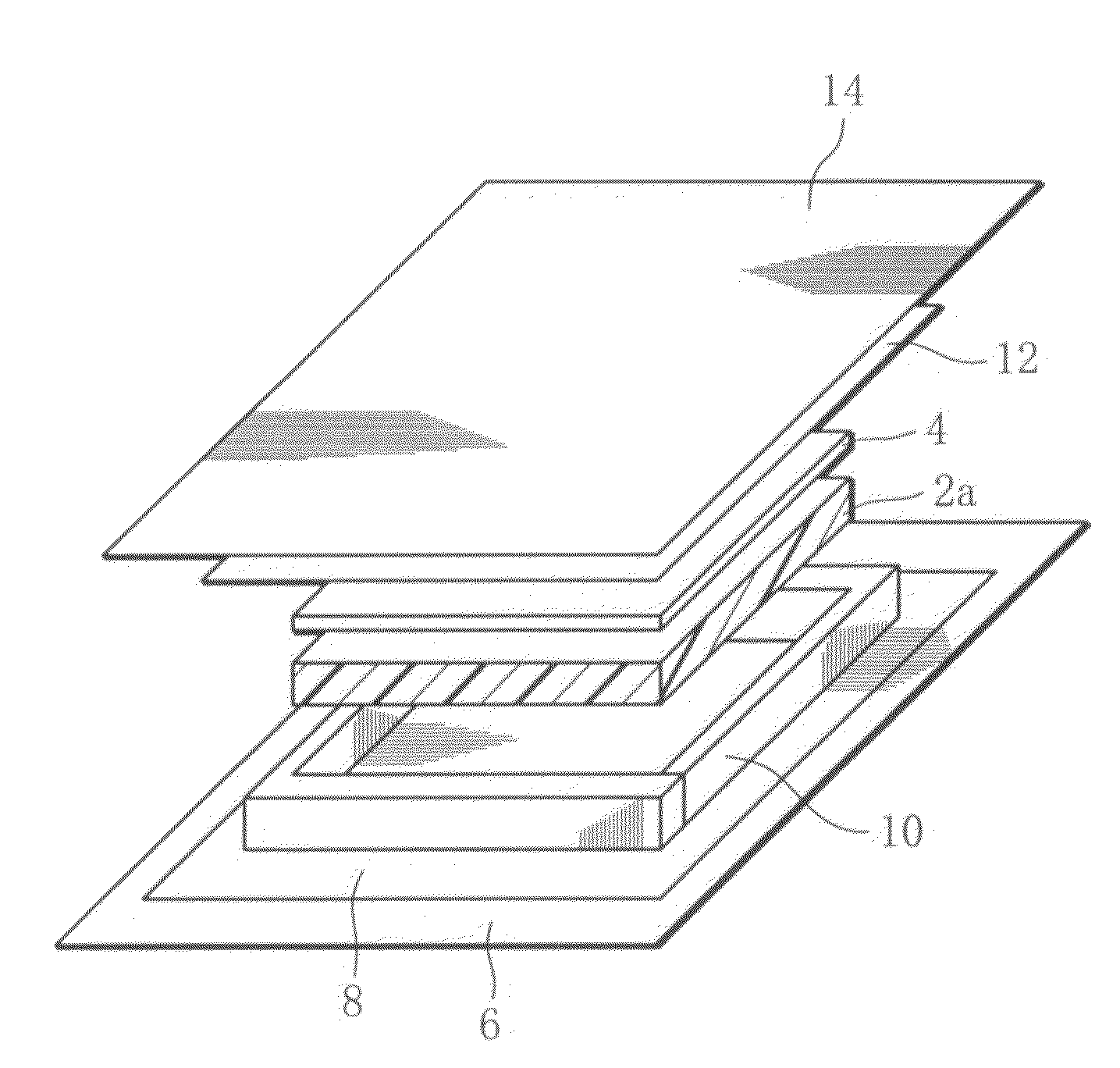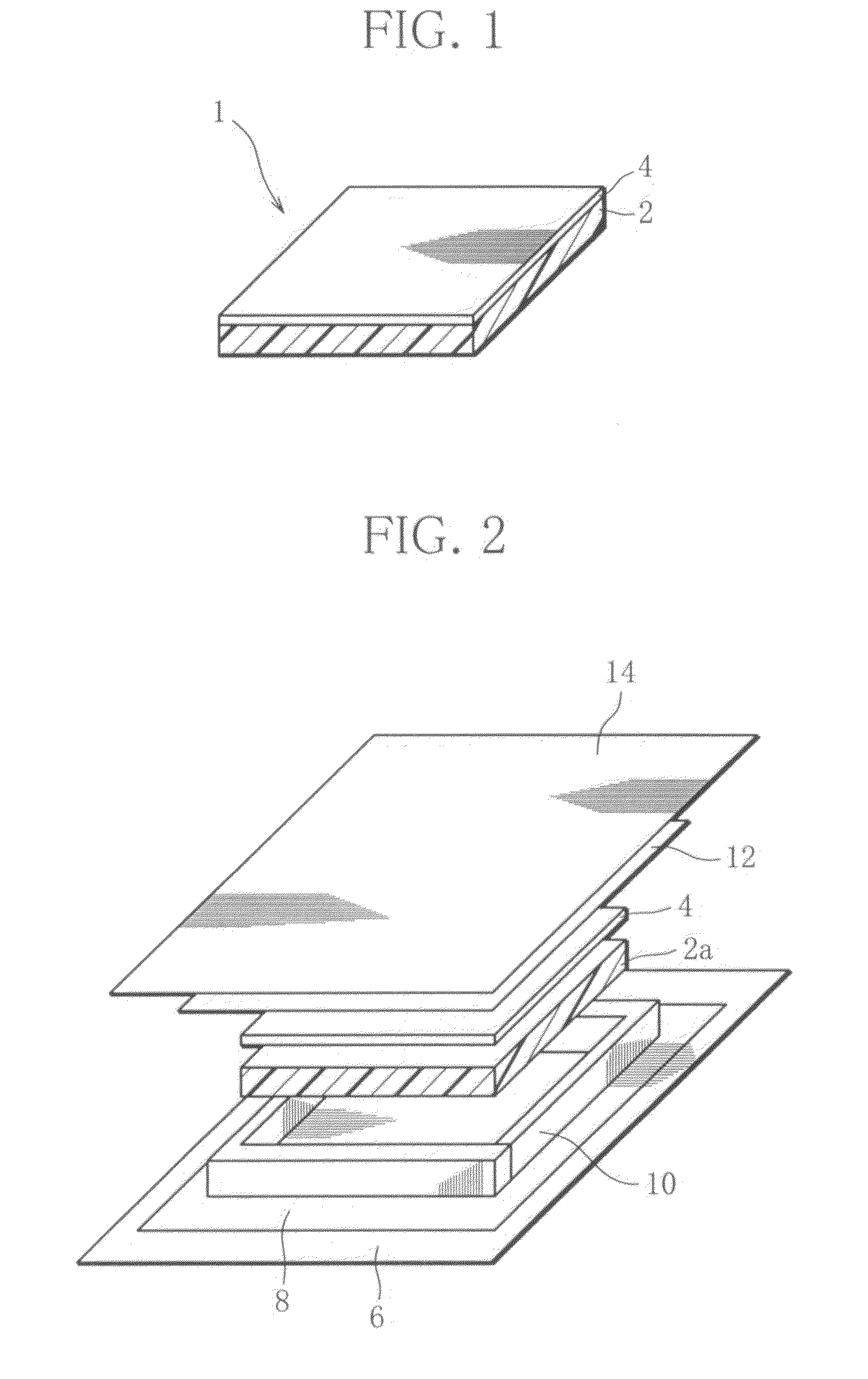Synthetic board with a film
- Summary
- Abstract
- Description
- Claims
- Application Information
AI Technical Summary
Benefits of technology
Problems solved by technology
Method used
Image
Examples
embodiment 1
[0049]As a film, a green-colored film (“GS Pla” made by Mitsubishi Chemical; grade: AD92W) of 25 μm in thickness was used, the film being produced by mixing 85 wt % of PBS resin with 0.70 wt % of cyanine blue, 1.80 wt % of cyanine green, 0.80 wt % of carbon black, 0.16 wt % of titanium white, and 2.5 wt % of polycarbodiimide as hydrolysis stabilizer.
[0050]As lignocellulose-based material, bamboo fiber having a length ranging from 25 mm to 70 mm was used. The bamboo fiber was obtained by crushing and fibrillating bamboo through machining.
[0051]The bamboo fiber was mixed with PBS resin by means of a fibrillating machine, and a preform shaped like a bulky mat was fabricated.
[0052]The preform was put into a mold, and was heated and pressed by a hydraulic press machine, to thereby mold a synthetic board.
[0053]The green-colored film was placed on the synthetic board, and was subjected to heating and pressing again by the hydraulic press machine. As a result, there was produced a synthetic...
embodiment 2
[0054]As a film, a deep blue-colored film (“TERRAMAC” made by UNITIKA) of 100 μm in thickness was used, the film being obtained by mixing 89 wt % of PLA resin with 6.00 wt % of cyanine blue, 0.40 wt % of quinacridone red, 0.70 wt % of carbon black, 2.00 wt % of aluminum pigment, and 2.5 wt % of polycarbodiimide as hydrolysis stabilizer.
[0055]As lignocellulose-based material, bamboo fiber having an average fiber length ranging from 10 mm to 90 mm was used. The bamboo fiber was obtained by crushing and fibrillating bamboo through machining.
[0056]The bamboo fiber was mixed with PLA resin by means of a fibrillating machine, and a preform shaped like a bulky mat was fabricated.
[0057]The preform was put into a mold, and the film was placed on the surface of the preform. The film and the preform were then heated and pressed by a hydraulic press machine so that molding of a synthetic board and affixment of the film were carried out at the same time. In this manner, there was produced a synt...
embodiment 3
[0058]Used as a film was a transparent film (highly flexible-type film made by Toray Industries, Inc.) of 100 μm in thickness, which was polymerized from dimer acid and 1,3-propanediol.
[0059]As lignocellulose-based material, bamboo fiber having an average fiber length ranging from 10 mm to 90 mm was used. The bamboo fiber was obtained by crushing and fibrillating bamboo through machining.
[0060]The bamboo fiber was mixed with PLA resin by means of a fibrillating machine, and a preform shaped like a bulky mat was fabricated.
[0061]The preform was put into a mold, and the film was placed on the surface of the preform. The film and the preform were heated and pressed by a hydraulic press machine so that the molding of a synthetic board and the affixment of the film were simultaneously carried out. Consequently, there was produced a synthetic board with a film, which had a transparent surface layer and had a rough texture of the bamboo fiber.
PUM
| Property | Measurement | Unit |
|---|---|---|
| Temperature | aaaaa | aaaaa |
| Time | aaaaa | aaaaa |
| Length | aaaaa | aaaaa |
Abstract
Description
Claims
Application Information
 Login to View More
Login to View More - R&D
- Intellectual Property
- Life Sciences
- Materials
- Tech Scout
- Unparalleled Data Quality
- Higher Quality Content
- 60% Fewer Hallucinations
Browse by: Latest US Patents, China's latest patents, Technical Efficacy Thesaurus, Application Domain, Technology Topic, Popular Technical Reports.
© 2025 PatSnap. All rights reserved.Legal|Privacy policy|Modern Slavery Act Transparency Statement|Sitemap|About US| Contact US: help@patsnap.com


